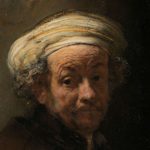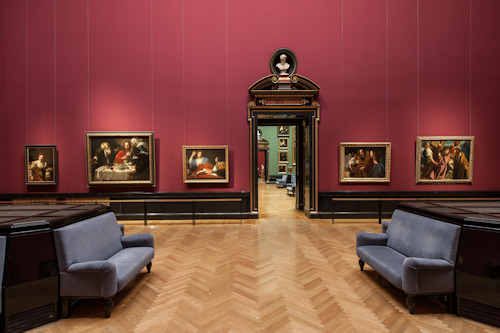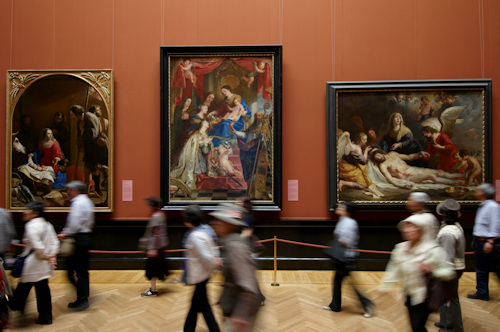
This is where some historical name dropping is called for. Raffael? Titian? Bruegel? Rubens? Holbein? Van Dyck? Dürer? Rembrandt? The Kunsthistorisches Museum’s picture galleries has them all.
- Numerous masterpieces from European art history
- Includes the world’s largest collection of works by Pieter Bruegel the Elder
- NB: Given regular exhibitions, paintings may move around
- Enjoy a bonus Klimt in the building, too
- Book your museum tickets* online
- …and skip counter queues
- See also:
Paintings galore

(Room V in the Picture Gallery; photo © KHM-Museumsverband)
The paintings occupy two wings of the first floor of the museum. One wing focuses on Italian, Spanish and French works, the other on Dutch, Flemish and German delights.
As with the Kunstkammer, the collection owes much to the curiosity, interest, and wealth of earlier Habsburg collectors, notably Rudolf II in the late 16th and early 17th centuries and Archduke Leopold Wilhelm in the mid-17th century.
The Archduke in particular had a nose for timely purchases. He exploited the English civil war, for example, to pick up a few masterpieces.
(While today’s European museums worry about visitor numbers and transport insurance, earlier collectors had other problems. Rudolf’s collection, for example suffered at the hands of rampaging Swedes in Prague at the end of the Thirty Years War.)
Put your feet up (not literally)
The paintings hang in tall galleries, but more or less at eye level. Which makes them easy to view, and the protective rails feature accessible, individual descriptions in both German and English.
A hushed reverence pervades the rooms, ruined only slightly by the squeak of shoes on wooden floors and the waving of smartphones.
Take a seat on the lovely upholstered sofas and contemplate whether Caravaggio’s 1601 The Madonna of the Rosary would fit in your bathroom. (Probably not…unless you have a very big bathroom).
Pieter Bruegel the Elder
Many of Europe’s greatest artists from the 15th, 16th, 17th, and 18th centuries lurk within these hallowed museum walls. But experts would probably say the works by Pieter Bruegel the Elder count as the most important.
The Kunsthistorisches Museum owns the world’s largest Bruegel collection, featuring such wonders as the iconic Tower of Babel (ca. 1563):

(Picture Gallery; photo © KHM-Museumsverband)
Among the various other notable works within: Bruegel’s Children’s Games from 1560, Hunters in the Snow from 1565, and The Peasant Wedding from 1568. The latter painting famously shows a leg at the bottom right that appears (possibly) to have no owner.
The “Bruegel gallery” probably ranks as my favourite in the museum.
The painted depictions of 16th century life are an absolute joy; you can spend many happy minutes imagining the various stories behind the scenes and figures in the paintings.
Myriads of masterpieces

(Room VI in the Picture Gallery; photo © KHM-Museumsverband)
The rest of the collections on display include numerous other world-class masterpieces. Highlights for me:
- Arcimboldo’s famous paintings of Winter, Summer, Water and Fire as faces
Arcimboldo created all the anatomical features through the clever placement of themed objects. A pod of peas for the teeth in Summer’s face, an oil lamp for Fire’s lower jawbone.
- Paintings of Vienna from the 18th century by Bernado Bellotto (also known as Canaletto)
Bellotto’s landscapes bring home just how much the city has grown. Schönbrunn Palace, now embedded deep within modern Vienna, really was a summer residence well outside the city.
- Peter Paul Rubens 1618 The Miracles of St. Francis Xavier
Next to the huge canvas sits the small Modello, basically the preliminary painting used as a model for the big one. This Modello is entirely Rubens; other artists in his studio helped finish the main painting. The difference in quality and subtlety is clear.

(Picture Gallery; photo © KHM-Museumsverband)
And here a few more you might recognise from history books and art documentaries:
- Hans Holbein the Younger’s 1536/1537 Portrait of Jane Seymour
- Albrecht Dürer’s 1519 Portrait of Emperor Maximilian I
- Peter Paul Rubens’ 1636/1638 Portrait of Hélène Fourment, showing his wife after emerging from the bath, partially wrapped in fur
- Raphael’s 1506 Madonna of the Meadow
Tip: another reliable location for seeing paintings by old masters (juxtaposed with contemporary and modern works) is the public gallery of the Academy of Fine Arts Vienna.
Klimt, too?

(The magnificent staircase inside the museum includes wall decoration by none other than Gustav Klimt)
Although the collection more or less ends with the 18th century, you’ll also find works by Klimt from around 1890. But not where you might think to find them.
Gustav Klimt, Ernst Klimt and Franz Matsch painted the areas between and around the arches and columns on the north wall of the main staircase. If you’re lucky, a Swarovski spotting scope opposite helps you get a closer view. To see more of Klimt in Vienna, try this guide.
Next: Once you’re done with the paintings, go up a floor to the coin cabinet and Vermeyen’s cartoons.